
Neptunia lutea, commonly called the yellow-puff, is an herbaceous plant in the legume family (Fabaceae). It is native to the United States, where it is primarily found in the South Central region, extending eastward into the Blackland Prairies of Alabama and Mississippi. Its natural habitat is in open areas such as prairies and savannas. It is tolerant of disturbed soil.
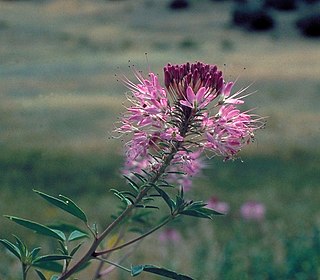
Cleomella serrulata, commonly known as Rocky Mountain beeplant/beeweed, stinking-clover, bee spider-flower, skunk weed, Navajo spinach, and guaco, is a species of annual plant in the genus Cleomella. Many species of insects are attracted to it, especially bees, which helps in the pollination of nearby plants. It is native to southern Canada and the western and central United States. The plant has often been used for food, to make dyes for paint, and as a treatment in traditional medicine.

Platystemon is a monotypic genus of flowering plants in the poppy family containing the single species Platystemon californicus, which is known by the common name creamcups. It is native to Oregon, California, Arizona, Utah and Baja California, and is found in open grasslands and sandy soils below 6,000 feet (1,800 m) elevation.
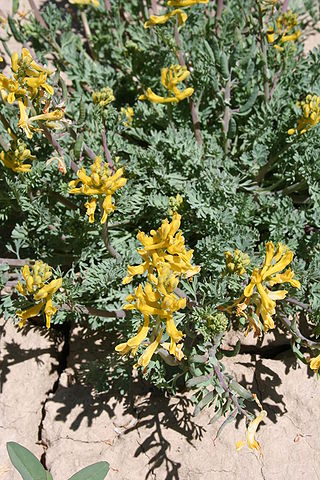
Corydalis aurea is a flowering plant in the poppy family (Papaveraceae), native to North America. A winter annual, it can be found in such areas as the sagebrush steppe.

Cerastium glomeratum is a species of flowering plant in the family Caryophyllaceae known by the common names sticky mouse-ear chickweed and clammy chickweed. It is native to Europe, Macaronesia to Assam but is known on most continents as an introduced species. It grows in many types of habitat. The blooming period is February, March, April, and May.
Cleomella sparsifolia is a species of flowering plant known by the common names fewleaf cleome and fewleaf spiderflower. This annual wildflower is native to California and Nevada where it grows in desert sand. This is an erect, branching plant not exceeding a meter in height. Its sparse leaves are each made up of 3 thick, oval-shaped leaflets. The bright yellow flowers have curving petals and long stamens tipped with knobby anthers. The fruit is a capsule up to 4 centimeters long.

Collomia grandiflora is a western North American annual plant in the phlox family (Polemoniaceae), known by the common names grand collomia, large-flowered mountain trumpet, and large-flowered collomia. It usually appears in sandy habitats and is cultivated as an ornamental.

Gilia brecciarum is an annual flowering plant in the phlox family (Polemoniaceae), known by the common name Nevada gilia or break gilia.

Crocanthemum greenei is a rare species of flowering plant in the rock-rose family known by the common name island rush-rose. It is endemic to the Channel Islands of California, where it grows in the chaparral of the rocky seaside slopes. It is present on three of the eight islands, where it has historically been threatened by feral herbivores such as the Santa Cruz sheep and is making a gradual recovery. It is a federally listed threatened species.
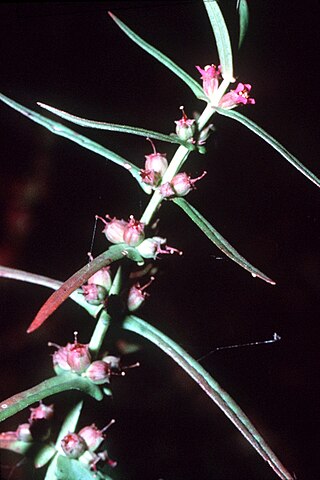
Ammannia coccinea is a species of flowering plant in the loosestrife family known by several common names, including valley redstem, scarlet toothcup, and purple ammannia. It is native to most of the contiguous United States, with the exception of the Pacific Northwest and New England. It is generally found in moist areas, such as riverbanks and pond margins. It is weedy in some areas. This is an annual herb growing erect to heights approaching one meter or lying along the ground. Leaves are linear in shape, up to 8 centimeters long, and green to shades of deep red in color. The inflorescence is a cluster of 3 to 5 flowers growing in the leaf axils along the upper part of the stem. The rounded flower has small rose to lavender petals each a few millimeters long and protruding stamens with yellow anthers. The fruit is a rounded capsule up to half a centimeter wide containing many tiny seeds.

Calochortus amabilis is a species of the genus Calochortus in the family Liliaceae. It is also known by the common names Diogenes' lantern, yellow globe-tulip, golden globe-tulip, yellow globe lily, golden fairy lantern, golden lily-bell, Chinese lantern, and short lily.

Calochortus leichtlinii is a species of flowering plant in the lily family known by the common names Leichtlin's mariposa, smokey mariposa, and mariposa lily.

Cleomella platycarpa is a species of flowering plant in the cleome family known by the common names golden bee plant and golden spiderflower. It is native to the western United States from northeastern California to Idaho, including the Modoc Plateau, where it grows on clay and volcanic soils in the sagebrush. It is an annual herb branching at the base into several erect stems up to about 60 centimetres (24 in) tall. The stems are green tinted with purple, coated densely in glandular hairs, and lined with many leaves. Each leaf is divided into three small leaflets. The top of each stem is occupied by a raceme of many flowers. Each flower has generally four yellow sepals and four yellow petals around a center of many yellow stamens. The fruit is a flat, hairy capsule up to 2.5 centimeters long which hangs on the long, remaining flower receptacle. Found between 800–1200m.
Cleomella brevipes is a species of flowering plant in the cleome family known by the common name shortstalk stinkweed. It is native to the Mojave Desert and adjacent hills, where it grows in wet alkaline environments such as mineral-rich desert hot springs. It is an annual herb producing a rough, waxy, red stem up to about 45 centimeters tall. The stem is lined with many small fleshy leaves, each divided into three leaflets. Flowers appear in the leaf axils all along the stem, often all the way down to the base. Each grows at the end of a short, erect pedicel. The flower has four tiny yellow sepals and four tiny yellow petals. The fruit is a somewhat rounded, hanging capsule developing at the end of the remaining flower receptacle.
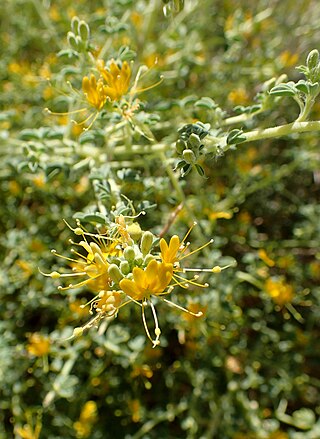
Cleomella obtusifolia is a species of flowering plant in the cleome family. It is commonly known as Mojave stinkweed, bluntleaf stinkweed or Mojave Cleomella. It grows in alkaline soils in the desert scrub. It is an annual herb producing a rough, hairy stem. The branching stem grows erect when new and then the branches droop to the ground with age, forming a bushy clump or mat. Each leaf is made up of three fleshy oval leaflets. Flowers appear in dense racemes on older stems and solitary in leaf axils on new stems. Each flower has generally four hairy green sepals and four yellow petals grouped together on one side of the involucre. The whiskery yellow stamens protrude up to 1.5 centimeters from the flower. The fruit is a hairy, valved capsule a few millimeters in length. It hangs at the tip of the remaining flower receptacle.
Cleomella parviflora is a species of flowering plant in the cleome family known by the common name slender stinkweed. It is native to eastern California and western Nevada, where it grows in desert and sagebrush scrub in the Mojave Desert and southern parts of the Great Basin. It is an annual herb producing a smooth, hairless, reddish stem up to about 45 centimeters tall. There are a few leaves, each made up of three elongated, fleshy leaflets. Most of the flowers are located in a raceme at the tips of the stem branches, and there may be a few solitary flowers in the axils of the leaves. Each flower has four tiny pale yellow petals, each about 2 millimeters long. The fruit is a lobed, valved capsule which hangs on the tip of the remaining flower receptacle.

Cleomella plocasperma is a species of flowering plant in the cleome family known by the common name twisted cleomella and alkali stinkweed. It is native to the Great Basin and Mojave Desert in the western United States, where it grows mainly in wet, alkaline soils such as those around hot springs. There is a disjunct population in the Bruneau Valley of southwestern Idaho. It grows with other halophytic species such as saltgrass and greasewood. This is an annual herb producing a smooth, hairless stem which divides into several erect or upright branches which may exceed half a meter tall. The sparse leaves are each split into three narrow leaflets. The flowers occur in a raceme at the top of each stem branch. Each flower has four yellow petals and several long stamens which may be over a centimeter long. The fruit is a capsule with large lobes. It hangs at the tip of the remaining flower receptacle.

Mitella ovalis is a species of flowering plant in the saxifrage family known by the common names coastal miterwort and oval-leaf miterwort. It is native to western North America from southwestern British Columbia, including Vancouver Island, to northern California as far south as Marin County. It grows in moist, shady habitat, such as coastal forests and streambanks.

Cleomella oxystyloides is a species of flowering plants in the cleome family, Cleomaceae, which is known by the common name spiny caper. It is native to the Mojave Desert straddling the border between California and Nevada. It grows in rocky and sandy desert habitat, often on alkaline soils. This is an annual herb producing an erect, branching stem which may reach 1.5 meters in height. The leaf is made up of three thick, firm leaflets 2 to 6 centimeters long, borne on a stout, straight petiole. The inflorescence is a dense head of flowers clustered about the stem at the leaf axils, each flower with four small yellow petals. The fruit is a small white or purple nutlet bearing the spine-like remnant of the flower receptacle.
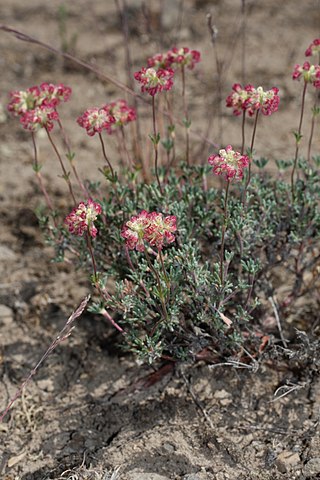
Eriogonum thymoides is a species of flowering plant in the buckwheat family known by the common name thymeleaf wild buckwheat, or simply thymeleaf buckwheat.


















